The Secret to Pocket Doors' Success
http://decor-ideas.org 07/08/2014 00:14 Decor Ideas
Pocket doors are particularly versatile architectural elements. They’re there when you need privacy and gone when you don’t. Selecting the actual door is a straightforward process — just pick something that suits the architecture of your house and be done with it. But picking the hardware — the pulls and tracks — is a much more detailed and nuanced process. Here’s what you’ll want to consider:
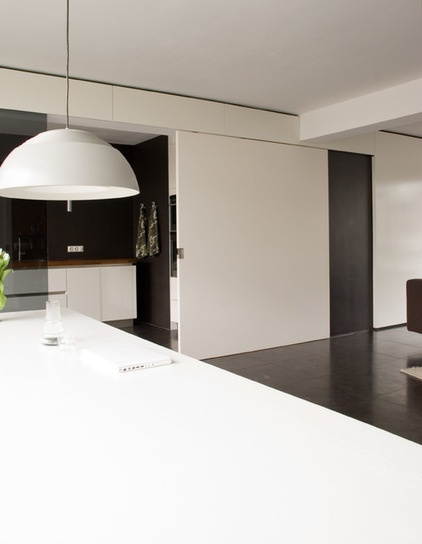
Tracks
Ceiling track. It all starts with selecting the proper track system for the doors to slide on. Typically pocket doors are top-hung. The track is recessed in the door opening, and the top of the door is affixed to the rolling trolley hardware or “running gear.” The trolleys are like a small set of roller skates that ride along the rails. So the track and trolleys must be sized to carry the weight of the door, and a big door like the one seen here weighs quite a bit more than a standard 32-inch to 36-inch-wide door.
This project used a track system by Häfele America Company called the Hawa Junior, which is a favorite of architects. The track is made from extruded aluminum, which is stable, uniform and lightweight. The trolleys roll on two nylon wheels with ball bearings — a combination that makes for low rolling resistance and quiet operation.
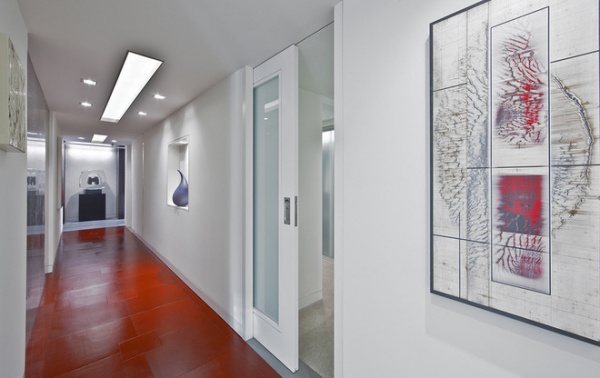
By choosing a full height sliding door here, the architect has maximized the opening and minimized the perception that it’s a door opening when the pocket door is fully open. Recessing the track is a clean, modern aesthetic, but it demands a high-quality track that won’t deflect under load or require future replacement. This is a permanent detail, so expect that the track price will reflect its durability.
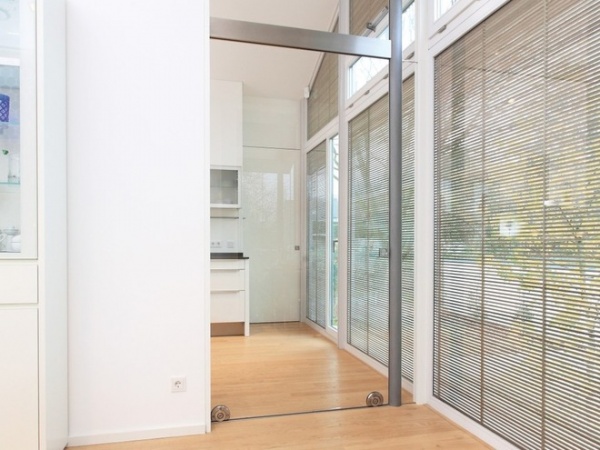
Floor track. This system by MWE uses a floor track and rollers. One of the advantages of a floor-mounted rail is that the top of the system can be relatively light because it doesn’t bear the weight of the door. It can be used in situations where the ceiling is either inaccessible or the bearing capacity of the structure above is unknown.
The downsides are that it requires a very level floor and the track can be an obstruction. MWE offers a recessed, concavely shaped track that helps to minimize this effect.
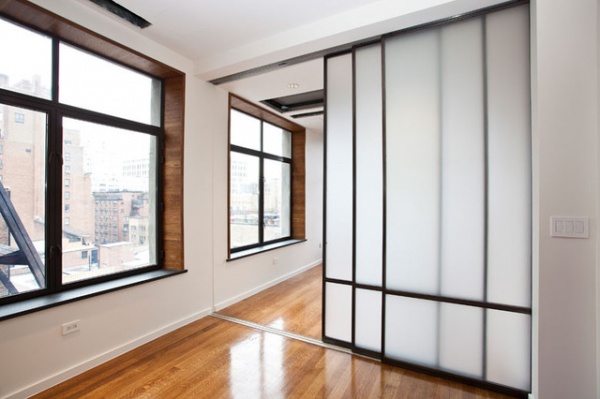
Ceiling and floor track (multi-pass sliders). Here again we see the popular Hawa Junior track from Häfele used for the top track, but with multi-pass sliding doors you also need some means of keeping the bottom of the doors in line and sliding as you’d expect. This usually means a floor track or guide to hold them in place. Floor guides can be a tripping hazard and can collect debris, so lower trafficked areas are best suited for this type of application.
All pocket doors will have at least one floor guide to keep the door bottom in the proper orientation. I like to position the guide just inside the pocket and size the door slab slightly thicker to allow it to remain concealed no matter the door’s position.
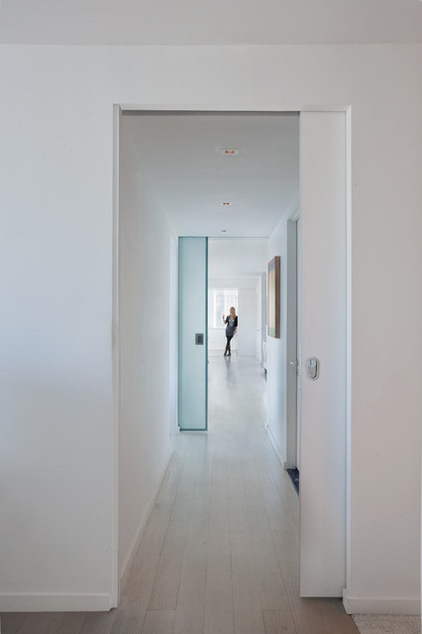
Sliding door track hardware is available for many different types of doors, not just solid wood ones. The trolley interface will be slightly different depending on the door substrate, but the track will be the same.
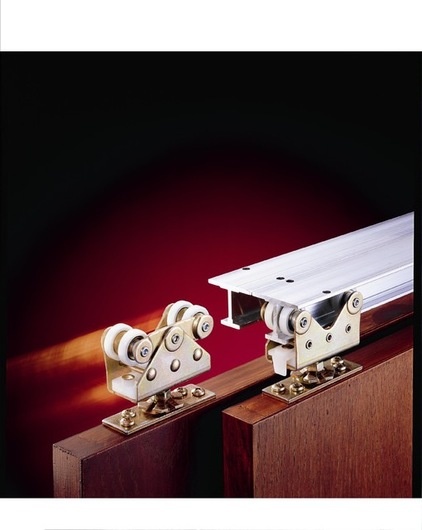
Heavy Duty Pocket Door Frame HardwareJohnson Hardware makes a slightly more cost-effective alternative to the Hawa. I used its heavy duty track system on the pocket doors in my own home. It’s also made from extruded aluminum, which ensures a uniform and even rolling surface.
Also, note the four wheels on the trolleys. You’ll often see trolleys that have three wheels on lower-quality sets; four is better because it ensures a more even rolling surface.
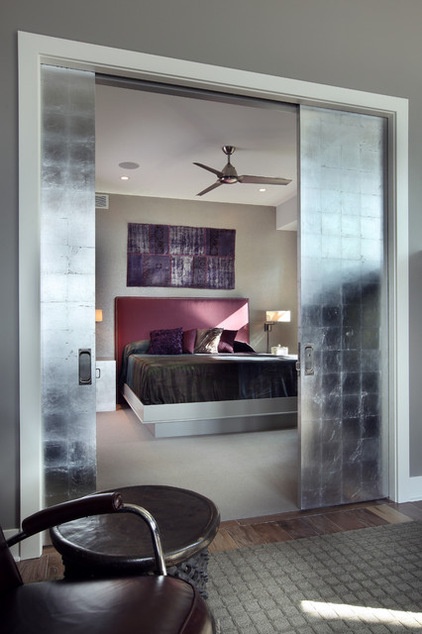
Bi-parting pocket track. With this type, you’ll want a way to center the doors and keep them from colliding. Track sets like the Hawa come with adjustable bumpers inside the track. The bumpers are like small sprung fingers that grab the trolley and stop it at a fixed point. These are set at the center to hold the doors in the exact position you’d like. For single pockets they’re set inside the pocket to keep the door from sliding too far inside.
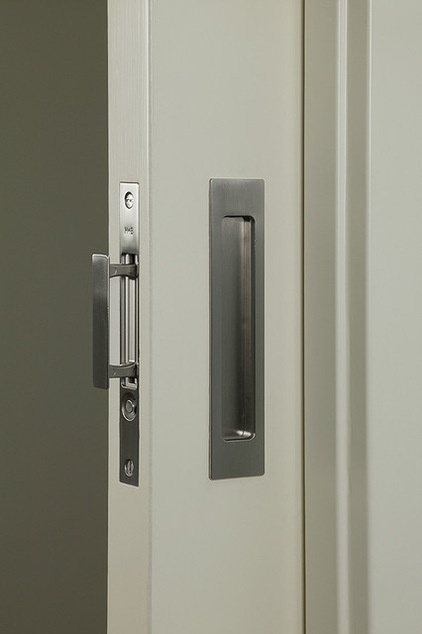
Mounting. You’re probably familiar with inexpensive pocket door hardware, the kind that mounts to a cutout in the edge of a door with a tiny indent and a small thumb-turn nib for locking. Steer clear of those; that hardware will make you hate pocket doors. They’re inexpensive, yes, but they don’t function well. Use a mortised set like the one seen here from Halliday and Baillie.
The resulting look and function is much more pleasant because it moves the recessed parts of the pull away from the door edge allowing easier access for your hands, and its larger size is easy to grip. Choose a mortised set for its looks and ease of use.
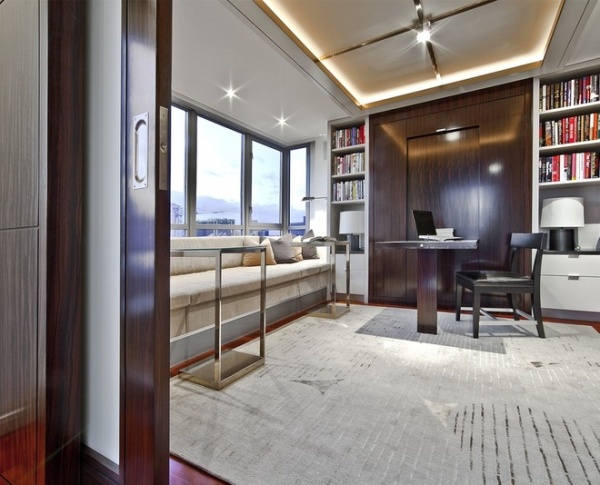
Pulls
The most visual aspect of pocket hardware selection is the pull, and there’s no shortage of choice when it comes to size and shape. Pocket pulls should be easy and comfortable to use. Because the door must fit within a limited pocket thickness, most pulls on pocket doors are flush pulls, meaning they don’t protrude from the face of the door stile.
When selecting pulls I avoid the stamped metal products characterized by their rounded edges. I look for crisp corners and, for most projects, concealed fastening. The base material should be selected to match the project aesthetic and use. Stainless steel is my default, but cast brass, bronze and plated finishes have their place, too.
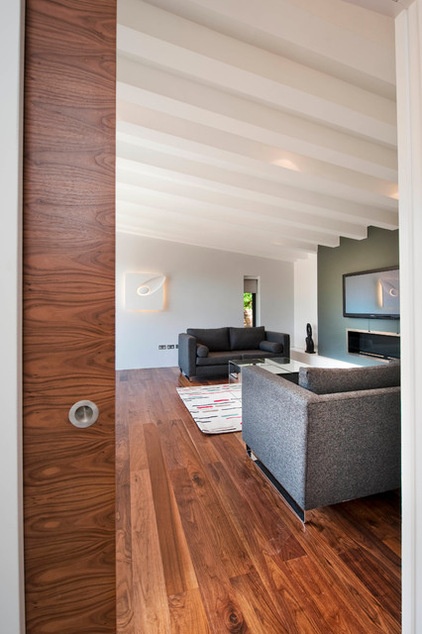
Circular pulls. Pay attention to the diameter of circle pulls. Too small on a large door and you’ll be sacrificing comfort and usability. These usually start at 1 inch and go up from there. Stay toward the 2-inch range for anything more substantial than cabinet doors.
Round pulls work well with door slabs (like the one seen here, without stiles and rails) because the comfortable diameter doesn’t overcrowd a narrow door stile.
See more on interior door parts and styles
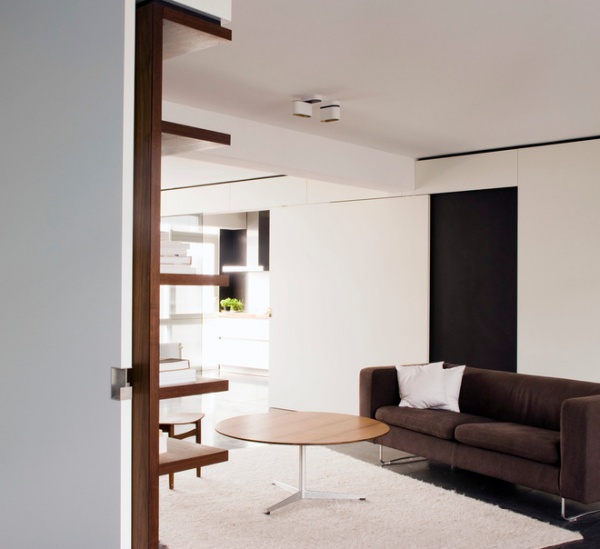
Rectangular pulls. This pull for a solid wood door is manufactured by FSB North America and is available in a range of standard and custom finishes. Its minimal profile doubles as a flush and edge pull.
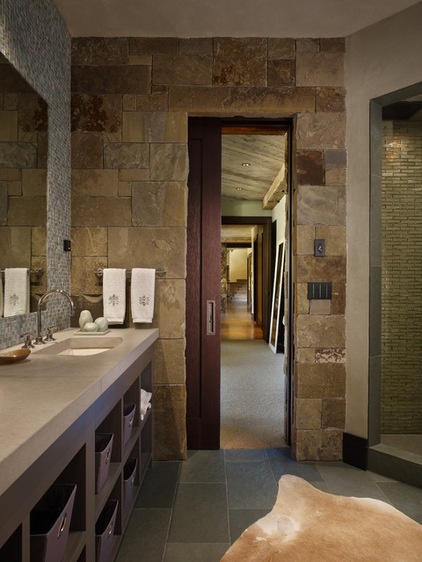
I like how this flush pull nicely matches the vertical proportions of the door opening and how it fits comfortably in the width of the door stile. Selecting a pull that’s too wide for the stile always looks awkward.
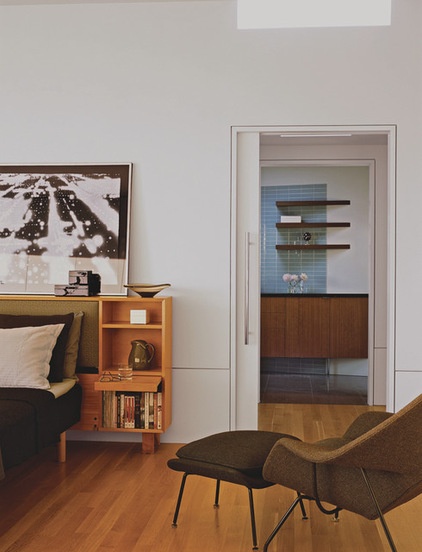
Bar pull or surface-mounted pulls. This is a great way of making a pocket door handicapped accessible. The pocket is framed in typical fashion, but blocking is added to push the door out by about 3½ inches. This gives room to mount the pull and allow for someone in a wheelchair or walker to open and close the door more easily. The finished opening is then sized to account for the reduced clearance.
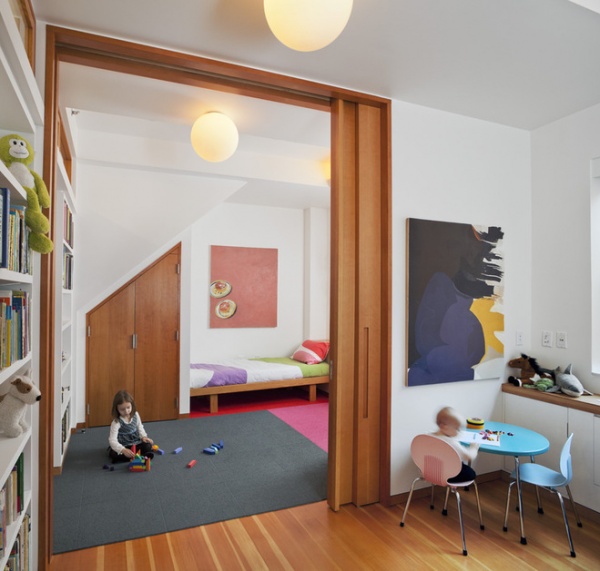
Custom pull. If you simply can’t find hardware you like, consider a custom solution like this one. The architect has carved out a flush pull from the face of the door and configured the door edge in a way that’s easy to grab and slide.
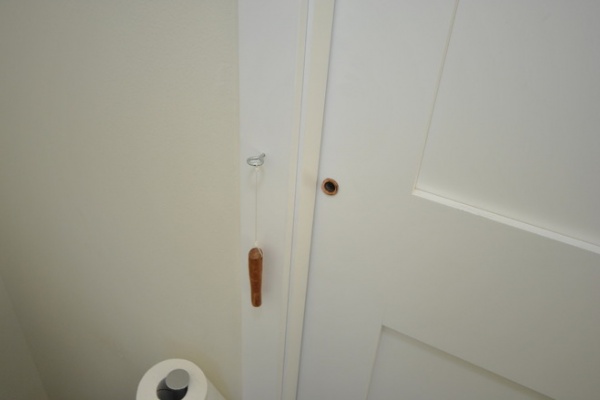
Design your own pull. This is perhaps my favorite of all of the examples because it employs a Shaker-like simplicity to the problem of door hardware and privacy. With the wood pin hanging, the door is free to slide into the pocket.
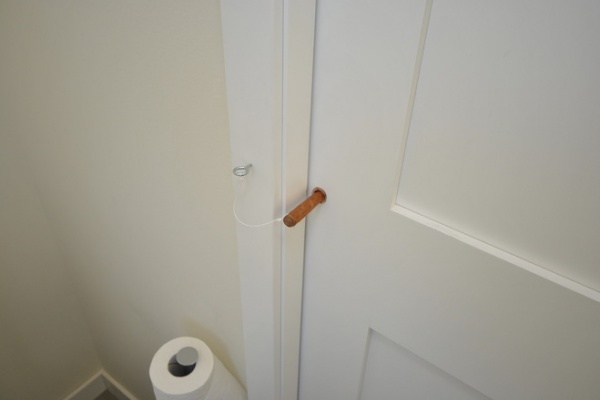
Insert the pin and the door is secure. The peg prevents the door from sliding into the pocket (toward the left of the image). I often find the analog solutions most pleasing because they so clearly show the designer’s ingenuity — and the price is usually hard to beat.
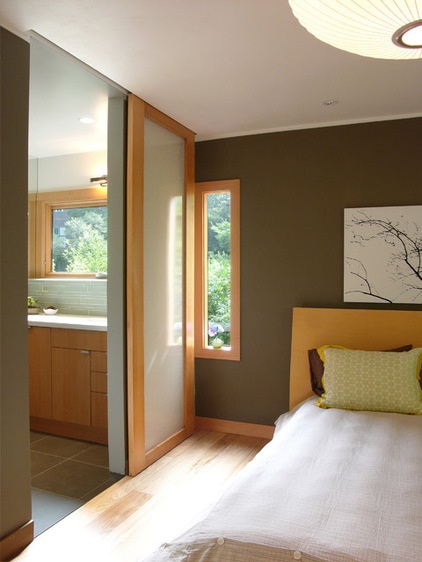
No pull. Simple and basic, these doors take a little more dexterity to operate, but the savings can be significant if you can live without the locking functions. Adding a recessed edge pull helps with the operation of a hardware-free slider and would be necessary in a pocketed situation.
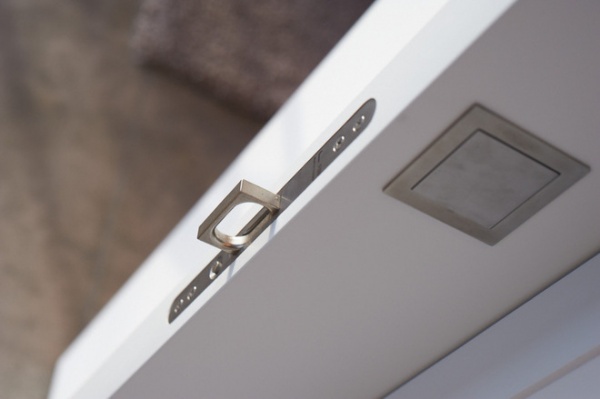
Pull size. When evaluating size it’s important to pay attention to the depth of the recess. The front face of the larger architectural pulls usually starts at 1½ inches wide by 4 inches tall by ¾ inches deep. These feel solid and are comfortable to use. While deeper pulls are easier to operate, they also require thicker doors. I like to use 1¾-inch doors for interior pockets, but most manufacturers offer hardware that’s compatible with standard 1⅜-inch-thick interior doors.
The hardware shown here also has an edge pull activated by a push button. When the door is fully open (recessed inside the pocket) you need a means of pulling it closed. The spring-loaded mechanism is reset when it strikes the door jamb. The pull seen here by FSB has a flush plate that’s spring-loaded for a completely flush look. The opening is a comfortable 2 inches square.
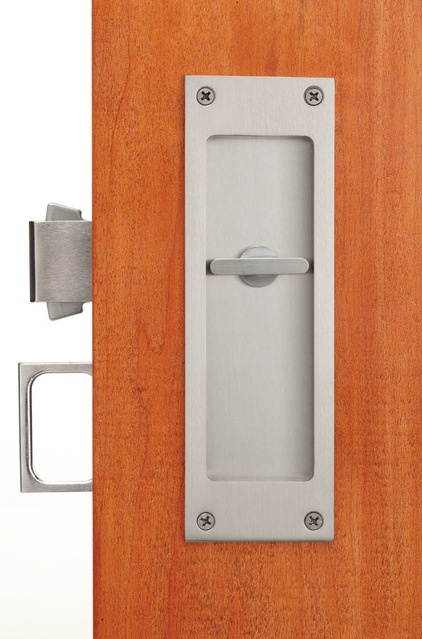
Pocket door locks and flush pullsPrivacy. Accurate lock company has skillfully solved the problem of privacy and pocket doors with its mortise pocket lockset. Shown here with an integral, spring-loaded edge pull that pops out with the push of a button, the pull and lock-turning mechanism is sized appropriately to allow for comfortable use, both for sliding and lock operation.
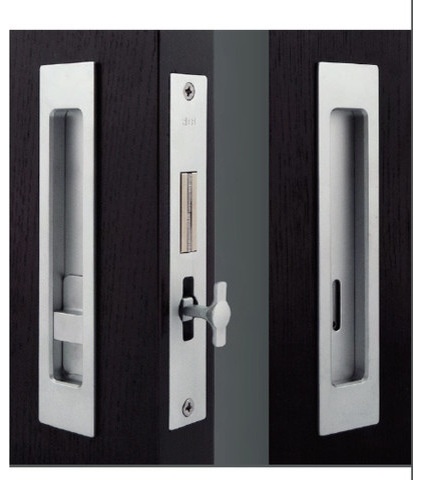
HB 690 Sliding Door Privacy Set - $598.50Another gorgeous locking pocket set, this one is made by Halliday and Baillie. They’re certainly not inexpensive, but the operation of the lock is smooth and controlled and they’ll last a lifetime. This has an added feature allowing the lock to be defeated from the exterior for safety purposes.
Here are some other heavy duty hardware manufacturers that offer a combination of great functionality and strong aesthetics that I like to use: Rocky Mountain, FSB, Sugatsune, Emtek, Baldwin, Accurate, Häfele America Company, MWE and Krown Lab. There are, of course, many others.
More: Upgrade Your House With New Interior Doors
Related Articles Recommended












